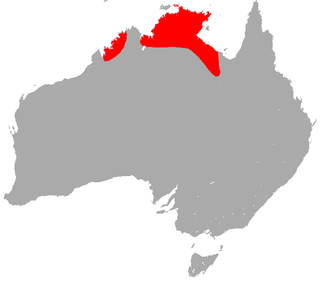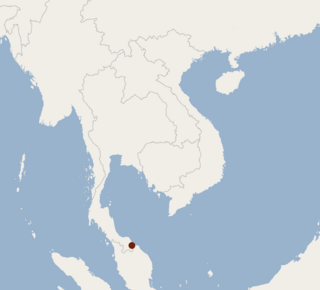
Gould's long-eared bat is a microbat found in southern regions of Australia. It occurs in eastern Australia, from Queensland to Victoria, and in a smaller isolated range in the south-west of Western Australia.

The dwarf dog-faced bat is a species of free-tailed bat from South America. It is found in Argentina, Bolivia, Brazil, Colombia, Ecuador, Guyana, Peru, Paraguay and Uruguay, typically at lower elevations. It is one of two species in the genus Molossops, the other being the rufous dog-faced bat. Three subspecies are often recognized, though mammalogist Judith Eger considers it monotypic with no subspecies. It is a small free-tailed bat, with a forearm length of 28.9–32.5 mm (1.14–1.28 in) and a weight of 5–8 g (0.18–0.28 oz); males are larger than females. It is brown, with paler belly fur and darker back fur. Its wings are unusual for a free-tailed bat, with exceptionally broad wingtips. Additionally, it has low wing loading, meaning that it has a large wing surface area relative to its body weight. Therefore, it flies more similarly to a vesper bat than to other species in its own family. As it forages at night for its insect prey, including moths, beetles, and others, it uses two kinds of frequency-modulated echolocation calls: one type is to navigate in open areas and to search for prey, while the other type is used for navigating in cluttered areas or while approaching a prey item.

The eastern or Queensland tube-nosed bat is a megabat in the family Pteropodidae that lives in north-eastern Australia. N. robinsoni is one of the few species of megabat that roosts solitarily. They get their common name from their raised tubular nostrils which are unlike those of most other species in the family. They are a deep brown with gray heads and sparse yellow spotting.

Murina is a genus of vesper bats. They are found throughout temperate and tropical regions of Asia.

Rüppell's or the greater broad-nosed bat is a species of vespertilionid microbat found in eastern Australia.

The northern broad-nosed bat is a species of the vespertilionid family of microbats. It can be found in northern Australia, Timor-Leste, and Papua New Guinea.

The eastern long-eared bat, species Nyctophilus bifax, is a small flying mammal, a vespertilionid bat. It is found in eastern Australia and Papua New Guinea.

Nyctophilus geoffroyi is a vespertilionid bat. a flying nocturnal mammal found in Australia, The species is relatively common. They have been referred to as the lesser long-eared bat.
The southern forest bat is a vesper bat found in Australia.

The fawn leaf-nosed bat is a species of bat in the family Hipposideridae found in Australia, Indonesia, Malaysia, the Philippines and Vanuatu.

The northern leaf-nosed bat is a micro-bat of the family Hipposideridae, known as "leaf-nosed" bats. The species is endemic to northern regions of Australia. They are highly manoeuvrable in flight, and use echolocation to forage for insect prey.

The demonic tube-nosed fruit bat is a species of bat in the family Pteropodidae. It is endemic to Papua New Guinea. The holotype specimen was collected in 1979 on New Ireland, in the Bismarck Archipelago. It was described as a new species in 1983. The range of the species may extend to other islands, however the extent of the range is not presently known.

The smaller horseshoe bat is a species of bat in the family Rhinolophidae. It is found in Australia and Papua New Guinea.

Nyctophilus is a genus of the vespertilionids or vesper bats. They are often termed Australian big-eared bats or long-eared bats, as the length of their ears often greatly exceeds that of the head. This genus occurs in the New Guinean-Australian region.

Hilgendorf's tube-nosed bat is a species of vesper bat in the family Vespertilionidae. In Japan they are called 'tengu komori', after the mythical creature called the Tengu. It was formerly thought to be a subspecies of Murina leucogaster, but is now known to be a distinct species.

Beelzebub's tube-nosed bat, also Beelzebub bat or demon bat, is a species in the vesper bat family Vespertilionidae, found in the Greater Mekong region of Southeast Asia, specifically the Quảng Trị and Gia Lai provinces of Vietnam. They have tube-shaped nostrils which assist them with their feeding.
Nyctophilus daedalus is a species of bat in the family Vespertilionidae, a flying mammal endemic to northern Australia. They are also referred to as the pallid long-eared bat or northern long-eared bat.

The Bala tube-nosed bat is a critically endangered species of bat found in Thailand.

Nyctophilus major, referred to as a western long-eared bat, is a species found in forests and woodlands of Southwest Australia.
The Javanese long-fingered bat is a species of bat from the Miniopterus genus native to Indonesia. A common misconception was that Miniopterus blepotis belonged to the M. schreibersii subspecies. M. blepotis was recognized as a distinct species after the Schreibersii complex was divided. This is backed up by New Guinean mtDNA sequence data that is ascribed to M. blepotis. Whether it is a complex made up of multiple species is unknown.















